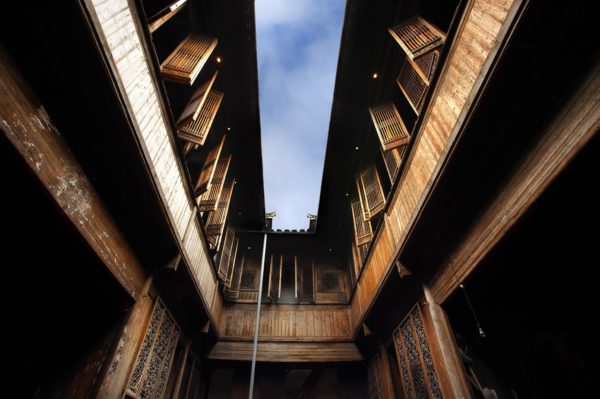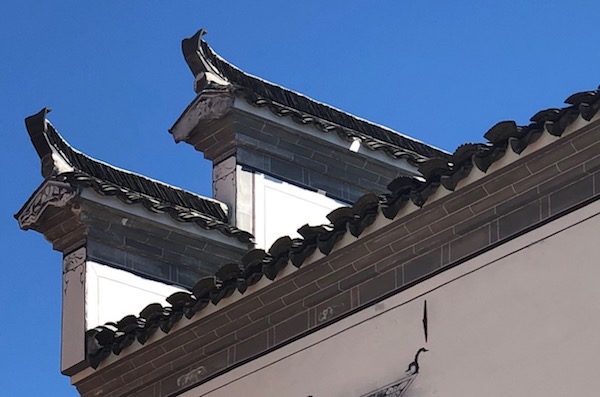Visual Arts Review: Yin Yu Tang — The Architecture of Daily Life at the Peabody Essex Museum
By Mark Favermann
Yin Yu Tang is a brilliant example of architectural and cultural collaboration that allows visitors to experience and learn about Chinese art, architecture, and culture.
Yin Yu Tang: The Architecture of Daily Life at the Peabody Essex Museum, Salem, MA, through September 26.

Skywell, Yin Yu Tang House, Peabody Essex Museum, Salem, MA,image by permission of Peabody Essex Museum. Photo: Dennis Helmar.
In a chaotic time, with our autocrat-wannabe U.S. President levying ill-conceived tariffs on Chinese products, examining the architectural aspects of China’s merchant history can provide an illuminating object lesson in cooperation. For over 200 years, eight generations of the same family lived in the Yin Yu Tang, a rural Chinese village house. It was originally built around 1800 for a merchant family. As part of a cultural exchange agreement with the local Chinese provincial authorities, the Peabody Essex Museum (PEM) was able to negotiate, obtain, disassemble, and eventually move the structure here.
With much planning and research, along with a bit of luck, PEM’s former Chinese Art and Design curator Nancy Berliner meticulously dismantled the house’s diverse components (including façade elements, furnishings, and household objects). It all was carefully catalogued, shipped across the Pacific, moved by truck to Salem, where it was painstakingly reconstructed with the collaboration of expert Chinese and American architects as well as preservationist builders. The result is a brilliant example of architectural and cultural collaboration that encourages visitors to experience and learn about Chinese art, architecture, and culture. If only current trade negotiations/non-negotiations had been so elegantly conceived and concluded? Perhaps Berliner should be involved in current China negotiations over trade?
This permanent exhibit at the Peabody Essex Museum is an expression of the exceptional quality of the institution’s mission and approach, which includes an architectural collection of historic American houses and properties situated near the museum. The Yin Yu Tang is the only Qing Dynasty House outside of China, making it a sterling example of PEM’s goal of linking the past and present while embracing “international artistic and cultural achievement by exploration of multilayered and interconnected creative expression.”
The Yin Yu Tang was built in the rural village of Huang Cun, a mountainous region in Southeastern China about 250 miles from Shanghai. Usually inhabited by groups of 20 or 30 individuals, the home hosted multiple generations of the Huang family. The fortunes of the family ebbed and flowed over the decades, with many of the men switching back and forth — serving as either merchants or bureaucrats — between larger municipalities and this home. The family’s wealth (or lack of it) reflected the fortunes of economics and politics in China over the course of two centuries.

Handcarved Lattice Screen Detail, Yin Yu Tang House, Peabody Essex Museum, Salem, MA. Photo: Kristen Phillips.
Yin Yu Tang’s exterior is a fine example of the Huizhou Style of architecture: high, stark white walls with black outlines and roofs. These timber-framed houses were designed to contrast, strongly, with the beautiful green hills and mountains of the region. The structures were meant to make for comfortable living — but to impress neighbors and visitors as well. Their austere, often 2-story fortress-like exterior white lime walls were often ornamented by small carved, tiled, or painted elements. The stepped walls were topped by an upturned roof tile design called a “horsehead” because it abstractly suggests a horse lifting its head.
Immediately upon entering Yin Yan Tang, the visitor moves into a courtyard topped by an open air skywell that allows for air and light in the interior space. Unlike the exterior, the courtyard walls are lavishly ornamented. Beautifully carved lattice designs emphasize assertions of refinement and former prosperity. On its first floor, Yin Yu Tang has an entranceway, a reception hall, a merchant’s room, a storage room, a grandmother’s room, a small room for firewood storage and a kitchen. At one time there were three kitchens in Yin Yu Tang because of its large number of residents.
In the courtyard, there are two small rectangular artificial Koi pools. Cleverly, these play a part in a fire prevention scheme. Bedrooms are located on the second floor; their windows and entrances face the skywell and are decorated by elaborate wooden lattice screens. Decorative carvings enhance columns, bases, and stone structural elements on the first floor as well. Stone pavers are placed on the first floor while the second floor contains wood floorboards.
Water was shared at communal wells in the village. The house was efficiently set up to be cool in the summer, but heating and warmth in the winter were much more challenging. Stairways were hidden behind walls. Wooden chamber pots and urinals were placed in bedrooms. Human and animal waste was strategically collected and spread on vegetable fields and gardens as fertilizer by family members of different ages.
Yin Yu Tang looks a bit threadbare and worn. Perhaps this is the result of wear and tear and/or long-term neglect. The house stood vacant for many years before its move to the Peabody Essex. Despite this fatigue, its ambience, structure, and details tell a cultural and architectural narrative history of nearly two centuries of rural Chinese living.

Horsehead Wall Treatment, Yin Yu Tang House, Peabody Essex Museum, Salem, MA. Photo: Kristen Phillips.
In contrast to the rustic Chinese abode, the Gardner-Pingree House provides an example of luxury urban American living in the early 19th Century. Located down Essex Street from the museum, this Brahmin merchant house is a masterpiece of Federal Style architecture. It was designed/built by the outstanding architect and woodworker Samuel McIntire in 1804. Because of its architectural significance, the house was designated a National Historic Landmark in 1972.
Rectangular in shape, the 3-story red brick structure is trimmed with white marble. Punctuated by two interior brick chimneys, the roof is surrounded by a low balustrade placed above an ornate cornice. All the windows proffer black shutters, each crowned by a lintel with a keystone. The house entrance is covered by an elliptical portico supported by four Corinthian columns; the door is framed by sidelight windows and an egg-shaped skylight. A decorative wrought iron fence surrounds the property. The interior is a ‘virtual’ portrait of 19th century upper class American gentility.
Though originally located 8,000 miles apart, Yin Yu Tang and the Gardner-Pingree houses were built at roughly the same time by successful merchants. Touring them stimulates cross-cultural meditations on the daily life and aesthetics of two seemingly unrelated cultures that have been (sometimes) linked by trade. The Eastern and Western variations on architectural detailing, interior finishes, furnishings, and everyday accessories lead to a fascinating but elemental question: what defines a home?
An urban designer and public artist, Mark Favermann has been deeply involved in branding, enhancing, and making more accessible parts of cities, sports venues, and key institutions. Also an award-winning public artist, he creates functional public art as civic design. Mark created the Looks of the 1996 Centennial Olympic Games in Atlanta, the 1999 Ryder Cup Matches in Brookline, MA, and the 2000 NCAA Final Four in Indianapolis. The designer of the renovated Coolidge Corner Theatre, he is design consultant to the Massachusetts Downtown Initiative Program. Since 2002, Mark has been a design consultant to the Red Sox. Mark is Associate Editor of Arts Fuse.
